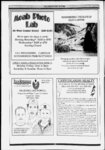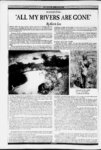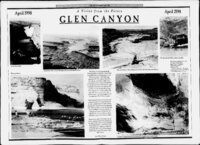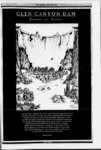| OCR Text |
Show VjiwivAvy.v.yJvisv.i ENVIRONMENTAL INTEGRITY ON THE COLORADO PLATEAU: Glen Canyon The Center of the Restoration Storm By Dave Wegner "You cannot save a place you do not know and love, you cannot behave ethically toward something you do not know and love, and you cannot behave ethically toward a planet as an abstract proposition". The prophetic words by Akio Leopold identifies for us the key essence to the restoration of Glen Canyon. We as a culture behaved unethically towards the environment and cultural heritage in 1956 when the decision was made to build Glen Canyon Dam. We did not know it well enough to save it. We did not understand the issues or the long-terimpact of those decisions. We must we take bold steps forward on behalf of the must must we and understand, appreciate for resources and Glen Canyon, if we are to work for solutions instead of band-aid- s m the shortsighted decisions of the past. Si41?.' !, was converted against its will to a bathtub. A beautiful bathtub not withstanding, but s. a stagnant body of water . none-the-les- So What? The Reservoir is Just Slower Mooing Water A dammed river creates a large stagnant body of water defined as a reservoir. Species that evolve in a river environment typically cannot survive in the stagnant waters. They need flow, direction and seasonally, without it they become disoriented Rivers downstream from dams also exhibit different and are quickly lost. characteristics than natural rivers. Over fourteen years of study conducted by the Glen Canyon Environmental Studies documented that the river environment downstream of the dam has changed. The artificially supported ecosystem is now dependent on daily flow regimes rather than seasonal ones and exotic species that depend on cold water regimes rather than seasonally warm ones. Exotic species take over temporarily, supported by a water regime that is artificially controlled by water users and politics. The Bureau of Reclamation and the water developers contend that Reservoir Powell is essential to meeting the water delivery requirements downstream and that draining the reservoir would cause the unraveling of water management in the West. In a report completed by the Environmental Defense Fund for the September 1997 Congressional hearing, using the Bureau of Reclamation's own projections and model, the following conclusions were made: The delivery of water to the Upper Basin states doesn't change at all. Average annual deliveries to the Lower Basin States would only be affected approximately 1 of the time (dry dry years) There will be a reduction in the existing loss due to evaporation by approximately 37 for the entire Colorado River system There will be an average increase in flow of 444,000 acre-fe- et per year to Mexico (for either consumptive use or for restoring the delta) A concern has been voiced that the electrical rates will skyrocket and that the distribution of electricity would be disrupted. Currently there is a glut of capacity and that economically energy on the market. So much energy exists on the short-termarginal power plants are closing. Information generated by EDF, using Reclamation models and numbers, showed that the scenario without Glen Canyon dam and power plant would result in an average annual reduction of 3 of total electrical consumption in Colorado, Utah, Arizona and New Mexico. That's barely a blip on the electrical market. Clearly the electricity produced is not critical to survival and immediate-mark- et Hydroelectricity is sold at Glen Canyon at both long-terrates. The sale rates are variable and dependent on whether the electricity is sold on a short-teror long-terbasis. The short-tercost of the electricity will not go up. Reservoir Powell basin traps sediments as they enter the stagnant waters. These sediments accumulate in the upper portion of the reservoir, and over time will fill the reservoir basin in. The timeline for when the filling of the reservoir basin will occur m The Escalante River at its confluence with the Colorado in Glen Canyon. The Glen Canyon Institute has a simple mission, the restoration of Glen Canyon. The alternatives for how to accomplish this will be evaluated in the Citizens Environmental Assessment. The Glen Canyon Institute's objective is to convince Congress, the Department of the Interior and most importantly the people, that restoring Glen Canyon is viable. We believe that the government that guided the dam's construction should be responsible for accepting the responsibility to restore it. Glen Canyon Dam was built during a time before the National Environmental Policy Act, Endangered Species Act, Clean Water Act, or any other federal laws that existed. The state and protect the resource and define a process for decision-makin- g, federal "water buffaloes" and developers lobbied the congressional delegations to develop and control the Colorado River. Their battle cry was that the economic and social future of the West rested with ensuring that the downstream water-hungr- y users of California, Arizona and Nevada did not lay claim to their undeveloped water. Glen Canyon would protect the dowry of the Upper Basin states from the water lecherous developers to the south. Glen Canyon was born as a political dam and continues to exist as one today. The trade-of- f in 1956 when Glen Canyon Dam was authorized for construction was that there would be no Echo Park Dam built to drown Dinosaur National Monument. Protecting the monument from drowning was a valuable and important cause, but as in all cases, there arc two sides to every stoiy. The trade off on this victory was the drowning of Glen Canyon. The area of the Colorado River known as Glen Canyon has had a long and valuable history, both culturally and biologically. Culturally it was home to thousands of Native Americans who lived in the side canyons and sowed seeds in the wet sands along the river. It was on these wet sands that they planted and harvested their crops. In this environment ancient civilizations evolved and cultures refined. The Native Americans came and went from the Colorado River area depending on climate and outside threats. Tragically, as the reservoir filled their history was drowned. Contractors raced about the basin salvaging all that they could find though their efforts were too little and too late. Thousands of ruins and artifacts are under the waters of Reservoir Pbwell waiting to be warmed by the sun once again. The biological integrity of the Colorado River watershed was defined by its uniqueness and diversity. The watershed evolved in isolation, separated from the oceans and as a result developed a unique assemblage of fish, insects and amphibians. These species evolved within the dynamic boundaries of seasonal hydrology, climate and geology, adapting to the habitats, large ranges in river flows and heavy sediment load. The species developed specific life history strategies to accommodate the variability of the watershed and river. They were unique and not found in other rivers. Glen Canyon Dam changed the dynamic nature of the river system by choking the flow of water, stealing the sediment and changing the water quality of the downstream releases. Changes began to occur immediately in 1956, as the flows of sediments the Colorado River were constrained. In the Grand Canyon, the the lifeblood of flows the and terminated the were cut off; aquatic high spring flushing that desecration the This to was was compromised. nothing though ecosystem of the river born environment of An occurred to the ecological integrity Glen Canyon. life-givi- ng m m m m The Stanton Gold Dredge in Glen Canyon. 0 is variable and dependent on the regional climate, runoff, sediment availability and upstream conservation practices. The estimates range from 150 years to 700 years. The issue then is not how long it will take but what will we do about it? The short-terimpact of increasing sedimentation and accumulation of heavy metals is another real concern. The Upper Colorado River watershed sediments were deposited in marine environments over 200 million years ago. Marine sediments are composed naturally of low levels of heavy metals including Mercury, Arsenic, Barium, and Selenium. Low levels of these metals move at rates defined by nature and the seasonal transfer of sediments. Such movements have not resulted in any profound environmental effect. With the reservoir in place however, the sediments are being unnaturally trapped and are being reduced chemically to forms that migrate into the water column and are picked up (assimilated) by the algae and zooplankton. Eventually the metals are bioaccumulated into the fatty tissuesof the StrincdsR and m . . . V 1 |









































